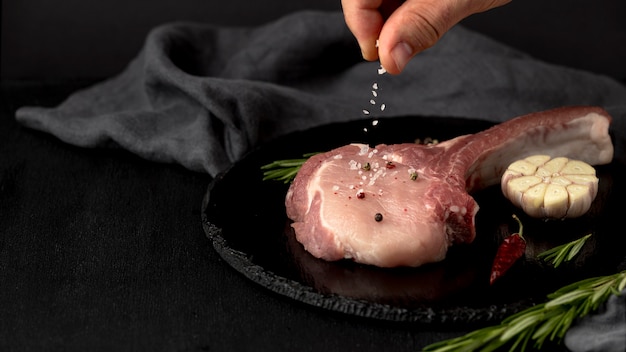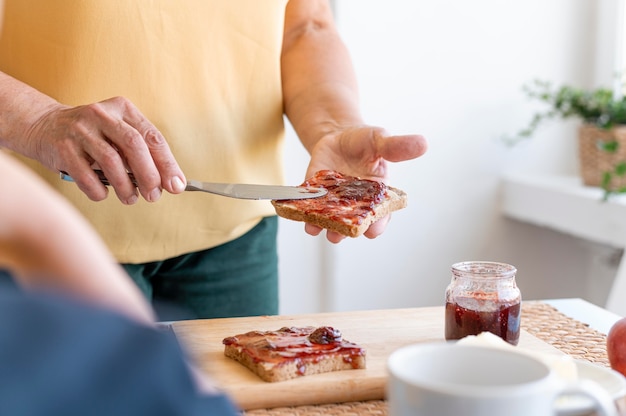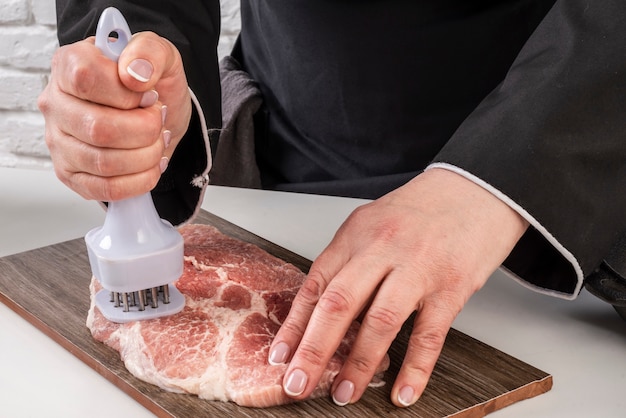There's a special kind of magic that happens when you bite into a perfectly cooked pork roast – the juicy tenderness, the rich flavour, and the satisfying aroma that fills the air. But let me tell you, I’ve learned the hard way that cooking pork isn’t just about flavour and texture. It’s about making sure everyone enjoys a safe and healthy meal. And that means understanding the importance of reaching the right internal temperature.
You see, undercooked pork can carry bacteria called Salmonella, which can cause food poisoning. That’s why cooking pork thoroughly is so crucial. It's about killing off these harmful bacteria and making the pork safe to eat. The trick is making sure the internal temperature reaches a safe level throughout the entire piece of meat.
I’ll never forget the time I was a bit younger and thought I knew everything about cooking. I attempted to make a pork loin roast for a family dinner. I cooked it to what I thought was the right temperature, but when I sliced into it, the juices ran pink. My heart sank. Thankfully, nobody got sick, but it was a real wake-up call. I realised I needed to take food safety seriously, and that includes understanding the science behind safe cooking temperatures. That’s what I'm here to share with you today – my journey into the world of safe pork cooking, and the things I’ve learned along the way.
Part 1: The Science Behind Safe Pork Cooking

1.1. The Porky Problem: Salmonella
Let's get down to the nitty-gritty. The main culprit we're concerned about with raw pork is a bacteria called Salmonella. It's sneaky, often hiding in raw pork, and can cause food poisoning. The symptoms aren’t pleasant – nausea, vomiting, diarrhea, and stomach cramps. No one wants to deal with that, so cooking pork properly is vital! The heat from cooking destroys these bacteria, making the pork safe to eat.
1.2. The Safe Temperature: 145°F (63°C)
Now, the big question – how hot does the pork need to get? Well, the USDA (United States Department of Agriculture) recommends cooking pork to an internal temperature of at least 145°F (63°C) and keeping it at that temperature for at least 3 minutes. This ensures those pesky bacteria are eliminated. You want to make sure the internal temperature is even throughout the entire piece of meat, not just in one spot.
1.3. The Importance of Even Cooking
Imagine you’re cooking a thick pork roast. It's tempting to think the outside is cooked through, but the inside might still be cool and harboring those pesky bacteria. That’s why using a meat thermometer is so important. It helps you ensure that the entire piece of meat has reached the safe internal temperature.
Part 2: Understanding Internal Temperature

2.1. The Meat Thermometer: Your Kitchen Companion
I’ve learned the hard way that a good meat thermometer is a kitchen essential. Don’t be afraid to use one! It’s the most accurate way to check the internal temperature of your pork. You can find them at most supermarkets and kitchen supply stores. I have a few different types – a digital one, a pop-up thermometer, and an instant-read one. It depends on the cut of pork I'm cooking. For example, the digital thermometer is great for a roast because it stays in place and provides a continuous reading. An instant-read thermometer is perfect for smaller cuts of pork, like chops or sausages.
2.2. Where to Place the Thermometer
Now, let's talk about placement. The best way to check the internal temperature is to insert the thermometer into the thickest part of the pork, avoiding any bone. You want to ensure it’s not touching bone, as that can give you a false reading. I find a digital thermometer with a probe really handy because it allows me to cook the pork without having to open the oven every few minutes.
2.3. Safe Temperatures for Different Cuts of Pork
The safe internal temperature for pork can vary slightly depending on the type of cut. Here’s a quick guide:
| Type of Pork | Safe Internal Temperature |
|---|---|
| Whole pork roasts | 145°F (63°C) |
| pork chops | 145°F (63°C) |
| pork tenderloin | 145°F (63°C) |
| Ground pork | 160°F (71°C) |
As you can see, ground pork requires a slightly higher temperature than other cuts of pork. This is because ground pork has a greater surface area, making it more susceptible to contamination with bacteria.
Part 3: Cooking Pork Safely at Home

3.1. From the Fridge to the Stove: Tips for Safe Cooking
Now that we’ve got the science down, let's talk about practical tips for cooking pork at home. Here are some things I’ve learned over the years:
- Always cook pork from a chilled state. It’s best to cook pork directly from the fridge. If you're defrosting frozen pork, make sure it's completely defrosted before you begin cooking.
- Don't overcrowd the pan or oven. Give your pork room to cook evenly. If you crowd it, it won’t cook as quickly and might not reach a safe internal temperature.
- Use a meat thermometer! This is essential for ensuring that your pork reaches the safe internal temperature. It’s a small investment that can make a big difference to your food safety.
- Let the pork rest after cooking. It's crucial to let the pork rest for at least 10 minutes after cooking. This allows the juices to redistribute throughout the meat, resulting in a more tender and flavorful pork.
3.2. Cooking Pork in the Oven: A Roasting Delight
I love roasting pork in the oven – it's a simple and delicious way to cook it. Here are some tips for oven roasting:
- Preheat the oven to 325°F (160°C). This helps the pork cook evenly.
- Season the pork generously. I like to use a simple blend of salt, pepper, and garlic powder. Feel free to experiment with other herbs and spices!
- Place the pork on a roasting rack. This allows air to circulate around the pork, aiding in even cooking.
- Cook the pork until it reaches the safe internal temperature. Use a meat thermometer to check the internal temperature of the pork.
- Let the pork rest for 10 minutes before slicing. This allows the juices to redistribute, resulting in a more juicy and flavorful pork.
3.3. Cooking Pork on the Grill: A Summertime Favourite
Grilling pork is a fantastic way to enjoy the summer season. Here are a few things to keep in mind for grilling:
- Preheat the grill to medium heat. You want the grill to be hot enough to cook the pork evenly, but not so hot that it burns.
- Cook the pork over direct heat for the first few minutes. This helps to sear the pork and create a nice crust.
- Move the pork to indirect heat. This helps the pork to cook through without burning.
- Cook the pork until it reaches the safe internal temperature. Use a meat thermometer to check the internal temperature of the pork.
- Let the pork rest for 10 minutes before slicing. This allows the juices to redistribute throughout the meat.
Part 4: Avoiding Food Poisoning
4.1. Safe Handling: Prevention is Key
They say "prevention is better than cure," and that's definitely true when it comes to food poisoning. I always make a point of following these hygiene rules when handling raw pork:
- Wash your hands thoroughly with soap and warm water. This should be done before and after handling raw pork. Scrub for at least 20 seconds to ensure you remove all traces of bacteria.
- Don't cross-contaminate. Keep raw pork separate from other foods, especially cooked foods. Use separate cutting boards and utensils for raw pork.
- Clean and sanitise surfaces. This includes your cutting boards, utensils, and any other surfaces that have come into contact with raw pork. You can use a solution of one tablespoon of bleach to one gallon of water to sanitise these surfaces.
- Cook pork thoroughly. This is the most important step in preventing food poisoning. Make sure that the pork reaches the safe internal temperature of 145°F (63°C).
4.2. When in Doubt, Throw it Out!
I've learned that if you're ever unsure whether your pork has been cooked properly, it's always better to err on the side of caution and throw it out. It's not worth risking food poisoning. I learned this lesson the hard way. One time I was making a pork stew, and I wasn't sure if it was fully cooked. I took a chance and ate a small piece. I woke up in the middle of the night feeling awful! Needless to say, I learned my lesson that day.
Part 5: FAQs
5.1. Can I cook pork to a lower temperature than 145°F (63°C)?
I know some people might be tempted to cook pork to a lower temperature, especially if they want it to be juicy and pink. But I wouldn't recommend it. It's essential to follow the USDA guidelines and cook pork to 145°F (63°C) to ensure it's safe to eat. Cooking to a lower temperature might not kill off all the harmful bacteria, putting you at risk of food poisoning. It's not worth the risk, even for a slightly pinker pork.
5.2. Is it safe to eat pork that has been pink inside?
Not necessarily. It’s a common misconception that if the pork is pink inside, it’s not cooked properly. The colour of the pork isn’t a reliable indicator of whether it’s safe to eat. The only way to know for sure is to use a meat thermometer and check the internal temperature.
5.3. How long can I safely store cooked pork in the fridge?
Cooked pork can be stored in the fridge for 3-4 days. Make sure you wrap it tightly in plastic wrap or aluminum foil. When you’re reheating the pork, ensure it's heated to an internal temperature of 165°F (74°C) to kill off any bacteria that may have grown during storage.
5.4. What happens if I eat undercooked pork?
Eating undercooked pork can lead to food poisoning, which can cause a range of symptoms, including nausea, vomiting, diarrhea, abdominal cramps, fever, and chills. Symptoms typically appear within 6-48 hours after eating contaminated food. If you experience any of these symptoms, it's important to drink plenty of fluids to avoid dehydration. In severe cases, food poisoning can lead to complications like dehydration, kidney failure, and even death. So, please, always cook your pork to the correct temperature.
5.5. Can I freeze pork?
Yes, you can freeze pork! It's a great way to extend its shelf life. You can freeze raw pork for up to 4-6 months. Just make sure to wrap it tightly in freezer-safe packaging, such as plastic wrap or aluminum foil, to prevent freezer burn. When you're ready to use the frozen pork, thaw it in the refrigerator overnight. Never thaw frozen pork at room temperature, as this can encourage bacteria growth.
Part 6: Enjoying Safe and Delicious Pork
Food safety is a top priority, but let's not forget the joy of a good pork dinner! Once you’re comfortable with the safety guidelines, you can start experimenting with different flavours and cooking techniques. You can roast it with apples and herbs, sear it in a pan and serve it with a tangy sauce, or even grill it with a smoky BBQ glaze. The possibilities are endless! Remember, cooking delicious pork isn’t just about flavour; it’s about ensuring you’re enjoying a safe and healthy meal. Now go on, get in the kitchen, and experiment with some delicious pork dishes!
Everyone is watching

How to Cook Frozen Lobster Tails Perfectly: A Step-by-Step Guide
RecipesLobster. Just the word conjures up images of lavish meals, special occasions, and a taste of luxury. But let's...

Pigs in a Blanket Cooking Time: How Long to Bake for Perfect Results
RecipesAh, pigs in a blanket. Just the name conjures up images of those delightful little parcels of crispy pastry en...

Pork Fillet Cooking Time: How Long to Cook It Perfectly
RecipesPork fillet, or tenderloin as it's sometimes called, is a real favourite in our house. It's so versatile, and...

The Ultimate Guide to Cooking Sweet Potatoes: From Roasting to Mashing
RecipesSweet potatoes. Just the name conjures up images of warm, comforting dishes, bursts of vibrant color, and a to...

The Ultimate Guide to Tender, Juicy Pulled Pork
RecipesRight, let's talk pulled pork. It's one of those dishes that just screams "comfort food," doesn't it? I mean...
